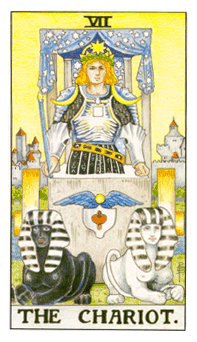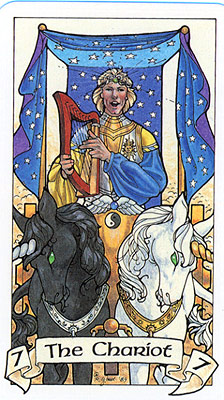
Sandra Thomson's specialty within
tarot is that of an author and teacher. She is the co-author of three
books (The Lovers' Tarot, Spiritual Tarot, and The
Heart of The Tarot), the author of Cloud Nine: A Dreamer's
Dictionary, and the author of a forthcoming dictionary of tarot,
Pictures from the Heart, published by St. Martin's Press.
She teaches tarot classes at the
Philosophical Research Society (PRS) in Los Angeles, where she resides.
Although she learned to read with the Rider-Waite-Smith deck, she is
very fond of the Ancestral Path and the Shining Tribe decks, and uses
them for comparative or special readings. She reads online for the ATA
reading networks, and privately.
|
|
|
The
Chariot is all about moving forward and about journeying, about
leaving home if we are an adolescent, about learning to journey
through our life with our own conscious direction, and about learning
to journey through life under the auspices of divine or higher spirit
(by whatever name you choose to use). Each of these journeys may take
place simultaneously, or more likely, through subsequent phases of our
lifetime so that the messages of The Chariot are always with us as we
seek to find our life's pathways.
|
|
 |
In the
Rider-Waite-Smith card, the charioteer has crossed the river and
leaves a village behind him, so perhaps one of the shadow aspects of
this card is failing to leave the past behind in the sense that we
remain a captive to the ways we were wounded by our families or others
in the past and never give that up, never understand how we can
transform that into something from which we can live a more positive
life, or never make the attempt to do so.
In many Chariot
cards, two lions (or sometimes mystical animals) pull the chariot and
they are of light and dark coloring and/or appear to be pulling in
opposite directions. They are symbols of duality, conflicting urges
(I warned you in an earlier essay that you would be tired of hearing
about that before this series is over).
|
 |
In the Ancestral Path
card, they are golden (solar aspect) and ebony (lunar aspect). We
must be guided by both and failure to acknowledge either will put us
in stalemate. I often think that's what the unmoving sphinxes in the
RWS card represent, the stalemate the charioteer is in because he
wants only to rule by his willpower and ignores the lower instinctual
aspects of his personality (some have described him as standing in a
"block" of cement rather than in a chariot). He has blocked off his
shadow aspects.
|
 |
Not so the Robin Wood
charioteer, who rolls along at such a fast clip that he raises a cloud
of dust behind him. This is a charioteer who is gonna roll right over
you in his ruthless urgency. No time to stop and listen to shadow.
He has much to
teach us about asserting ourselves, but may not have time to stop and
listen to his wife's complaints that he is never home and when he is,
doesn't listen to her. There's not a whole lot of time to stop and
listen to the gentle call of love. And, if he's in a conquest for a
woman, he'll have a devil of a time taking "No" for an answer (Perhaps
a more pathological shadow of the charioteer is the stalker). Most
likely Robin Wood's charioteer is a workaholic, who cannot recognize
his own feelings of inadequacy in that syndrome and covers it with the
"shadow pride" that he is indispensable (it won't get done without ME,
ME, ME).
|
Often the charioteer
has no reins and must either trust the power of his will and mind (the
battle within) or that of the harnessed animals to propel him along
his life path. Tracey Hoover, writing the book for the Ancestral Path
deck, regards him as a spiritual warrior (in this card his "canopy" is
the open sky above). Part of the battle is to recognize that there
are times when our aggressive and assertive instincts serve us well
and we need not repress them (where they may emerge as illness), but
rather need to make friends with them and know when to call them into
action.
|
|
Juliet
Sharman-Burke and Liz Greene in writing about the charioteer as the
war good Ares, suggest that with The Chariot card The Fool learns to
handle his contradictions. I believe we learn to recognize and handle
our contradictions in different ways through many cards in the Tarot
deck. It's a never ending task, and if we get mired in the related
ambiguity (one of the many faces of shadow), our forward movement
collapses and the shadow rules. |
I know it is not so
(well, maybe it is if I can imagine it), but I often imagine the
bottom of the chariot as being hinged like one of those trap doors on
a stage, where actors can ascend and descend, or which, in sophomoric
humor or villainous intent, can suddenly open and send a person
tumbling below. If we consider the canopy above the charioteer as the
divine cosmos, and the area beneath his chariot as the underworld,
then he stands squarely in the middle, but the trick trapdoor holds
the potential to open at any moment and send him tumbling into the
shadow world. "Gotcha," says the shadow.
|
|
In one of those
wonderful puns associated with Tarot cards, Pamela Eakins (Tarot of
the Spirit) says the card represents "time to clear out." She also
writes that the chariot is the vehicle for expression of the spirit.
So one of the shadow aspects of The Charioteer is failure to
acknowledge and express your spirit, to clear out that accumulated
negativity (we all have it, gulp) and to let your soul/higher self
(whatever words you use) "take off" and propel you forward into new
choices, activities, and ways of being. |
Lon
Milo Duquette, a member of our ATA Advisory Board, thinks that what's
hidden in the chariot is the Holy Grail. Now if you remember your
Arthurian tales, then you know that the story of the Holy Grail is all
about Parsival's travels through life until he has encountered enough
"wisdom" experiences to be able to ask the "right question" and restore
the wasteland of the wounded Fisher King. Another aspect of the shadow
side of this card, then, would be, failing to pursue shadow knowledge in
order to achieve enough wisdom to ask the proper question.
As I
indicate in The Lovers' Tarot, carefully formulating a question for
a tarot reading steers us between what we know in our conscious awareness
and the reservoirs of information in our unconscious. When you formulate
the question that resonates with your heart's wish to know, you set up a
sympathetic vibration to the appropriate answer. If we consider The
Chariot card as that which instructs us in how to ask the right question
(pay attention to the treasure hidden deep in your chariot and the spirit
above or surrounding you), its shadow aspect would have to be ignoring the
Self's need to know, and asking superficial, shallow questions rather than
questions the answers to which will guide you toward fullness and growth.
|




